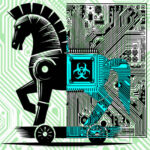Tip of the Week: Network Security Basics
 The modern threat landscape is filled with horror stories of people that have been the victim of software vulnerabilities, hackers, and situations that could have been managed differently. Today, we will go over some of the best ways to keep your business from being a victim of a data breach, data theft, or malware attack.
The modern threat landscape is filled with horror stories of people that have been the victim of software vulnerabilities, hackers, and situations that could have been managed differently. Today, we will go over some of the best ways to keep your business from being a victim of a data breach, data theft, or malware attack.
Authentication
The best place to start is at the beginning. The first tip is to have strong authentication procedure. Most machines, network-attached devices, and wireless devices that use company Wi-Fi will already have a password-based authorization system. With strong enough passwords in place, a password-only system can be enough to keep most threats out, but these days your business depends on you being sure that all threats are prevented. A multi-factor authentication (MFA) system is a great solution to this issue. Often deployed with two-factor authentication (2FA), an authentication system works to make getting into a system more difficult, therefore enhancing security.
The way two-factor authentication works to secure authorization is pretty simple. A login system with a password is used as normal, but after the login and password are entered, instead of taking the user to the information, it takes them to another screen that requires a randomly-created code processed by a third-party authentication app to be entered. Most people choose to use their mobile device to facilitate (and expediate) the entire process. If this is the case, the device has to be given authorization by an administrator of the 2FA system. Ultimately, for the modern small business, 2FA can improve their authentication procedures enough to ensure security is maintained.
Protecting Your Environment
For the Local Area Network or Wide Area Network, security best practices are pretty straight forward. First, you start with authentication (of course), but in order to secure the machines and data that make up the computing network, there needs to be a dedication to three entirely separate strategies. They are: software, physical security, and training.
Software
Software has long been a part of a comprehensive network security strategy. Firewalls, antivirus, content filtering, spam detection, and other software tools are deployed to protect organizational data. Some organizations are now using email encryption systems to ensure that business messages aren’t able to be intercepted.
Tip: To find the right software solutions, and where to deploy them, consider your organization’s data flow. The more you know how your data flows, the easier–and more cost effective–implementing security will be.
Physical Security
You may not think that physical security is that important to protect network security, but all it takes is one person to gain one set of login credentials to put your whole endeavor in jeopardy. Deploying biometric authorization for your business and server room has become en vogue recently, while a dedicated surveillance system with alarms and cameras can make all the difference in protecting your physical hardware and access information.
Tip: To ascertain what kind of physical security you need to implement for your business, hiring an outside consultant may be the best way to get the kind of security-first perspective you need to ensure your data, hardware, and staff remains safe.
Training
With so many threats out there, every business needs to have a comprehensive training platform in place to help educate and test your staff, who are statistically the weakest link in your whole organization’s network security strategy. You need to make sure they know what threats are out there; and, what their responsibility is in keeping your network free from threats.
Tip: Phishing is the number one problem for businesses and individuals, alike. Start there and move to more complex issues as needed. Everyone will be more effective the more cognizant they are of phishing tactics and remediation practices.
Remote Solutions
Nowadays, organizations need solutions to protect their physical networks, but they also need to ensure that their staff’s mobile devices don’t bring in unwanted problems onto the network; and that workers that work outside the confines of the LAN or WAN can have access to company files and resources.
Cloud computing has been one of the fastest-growing technologies for businesses. Since it transfers costs and eliminates some major capital expenses, it is being rolled out more now than ever before. The cloud also gives people outside the network the ability to access data and applications remotely. Many cloud platforms come completely managed and with powerful security and privacy options to ensure resources are secure.
Since most people nowadays rely on their mobile devices, businesses have to have a plan on how to manage them–or, better yet, use them–to the organization’s benefit. Creating a Bring Your Own Device (BYOD) policy that utilizes powerful mobile device management software to give you control over endpoints is the smart way to handle these problems.
Network security needs to be a major component of your IT strategy. For more information about how Ashton Technology Solutions can help, call our certified professionals today at 216 397-4080.






